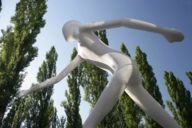
It is right in our midst, and yet we hardly know it: Munich’s public art – statues, sculptures and installations by world-famous artists, and which shape the city’s image. We asked some passers-by what they thought.
“Is it possible that this piece is a reminder of the old promenade along Leopoldstrasse, back when Schwabing was a little more ‘Bohemian’?” (Dagmar P., coach, Munich)“
“A city tour guide told me that the insurance workers who work in offices overlooking the back of the Walking Man often talk about Bottom Level. I think that refers to the second floor of the building.” (Viola S., system administrator, Munich)
“I interpret the statue as a representation of a businessman hurrying tirelessly on his way. He is so lost in his own thoughts, he has left his briefcase behind on the U-Bahn (underground)... Am I right?” (Lars U., student, Munich)
American painter and sculptor Jonathan Borofsky created the Walking Man as a permanent installation for Munich-based reinsurance company Munich Re. The sculpture is 17 metres high and stands like an outlandish entrance gate in front of the new insurance building, allowing people to pass through its legs. The company sees “the willingness to start afresh and a spirit of discovery (...) in the air and posture” of the figure. The artist, who also created the Molecule Man in Berlin and the iconic Hammering Man in Frankfurt, has not offered any personal interpretation.
“Looks like a huge hourglass – is the whole thing meant to express how fleeting everything is?” (Evi R., schoolgirl, Munich)
“It’s a strange thing – reminds me of an oversized pile of Mikado pick-up sticks that is collapsing in on top of itself.” (Holger W., business consultant, Munich)
“Ah yes, the Mae West – I know that the bars are heated in winter. That causes long icicles to form, which could fall on the roofs of the trams that pass through it.” (Klaus S., teacher, Munich)
Installation of this sculpture was preceded by intense debate. Munich’s former mayor, Christian Ude, felt that the design resembled an egg cup, and flower stand. In the end, the city council voted 40 to 35 in favour of the piece by Rita McBride, which cost 1.54 million euros. McBride hoped that the reference to the Hollywood actress, with her hallmark tight-fitting outfits, would help win support from decision-makers for her special model of a rotational hyperboloid, during the difficult voting process. The 52-metre high sculpture acts as a landmark without taking up a huge amount of space.
A globe – it’s obvious! It represents increasing networking, doesn’t it?” (Rainer R., taxi driver, Munich)
“Always a poetic structure – I think the sculpture is just meant to be beautiful. But how did it even get here?” (Sabine W., physiotherapist, Munich)
“An abstract dandelion clock? A snowflake? A steel peony? Somehow, it seems to me that this floating thing could be anything!” (Daniela H., insurance broker, Freising)
The large, suspended steel mesh ball in the Viscardi courtyard, created by Danish-Icelandic artist Ólafur Elíasson reflects increasing global networking. It is not the only work by Elíasson that is displayed in Munich’s public spaces. He is also the creator of a staircase sculpture in the form of a double helix (in the inner courtyard of the KPMG building), as well as the violet-blue reflective façade of the Bayerische Staatsoper’s (Bavarian State Opera) rehearsal building on Marstallplatz.
“Did he have too much to drink last night? Looks like the poor guy is throwing up!” (Matthias R., student, Munich)
“Yoga with a walking stick? Or what is it meant to be? I can’t make any sense of this piece.” (Louise C., tourist from London)
“The figure is looking down – maybe because the Egyptian Museum is buried underneath?” (Peter S., pensioner, Munich)
Standing 3.6 metres tall, the sculpture is the work of Dutch sculptor Henk Visch, and is part of the sculpture park in the Pinakothek district. The slender red post on which the head of the figure rests as it bends forwards, represents its line of sight. This line, which protrudes into the ground, does not simply refer to the Egyptian Museum located directly below, but also forms a physical link between the surface and an exhibition room underneath.